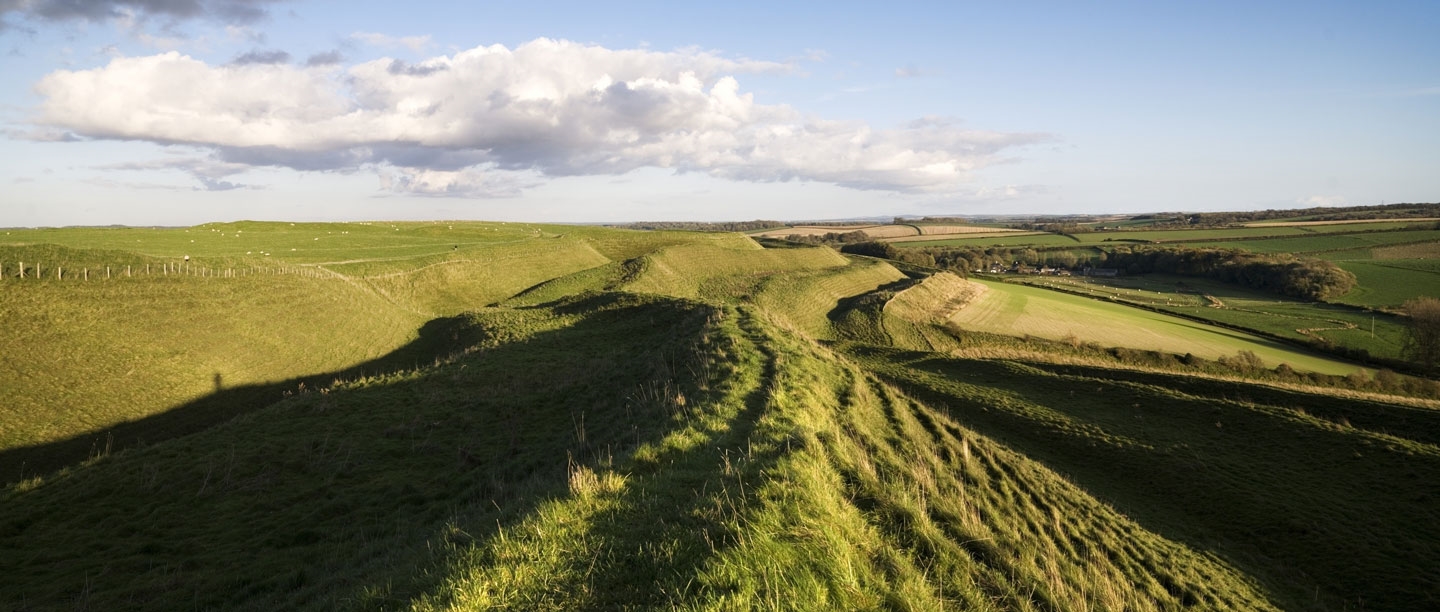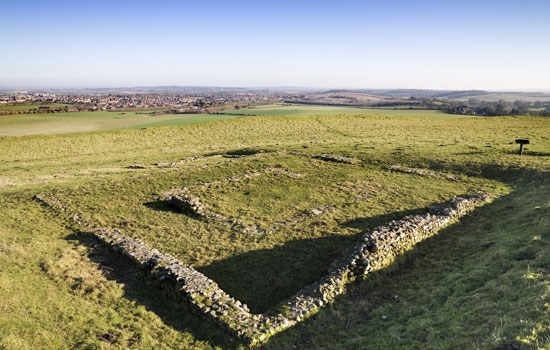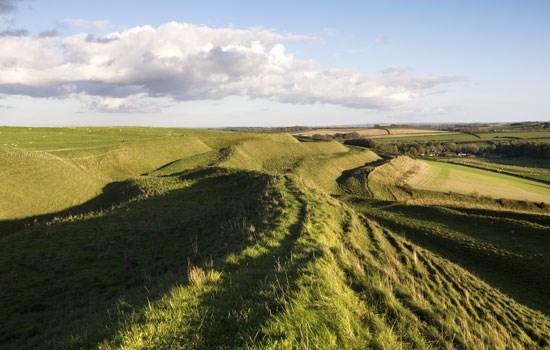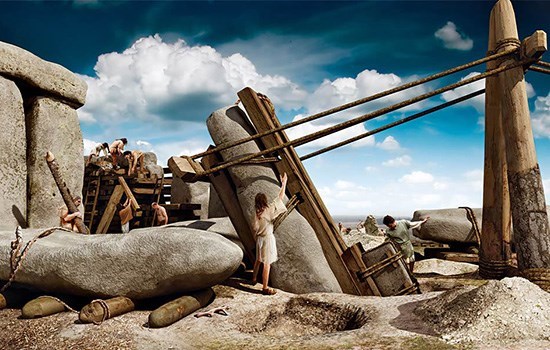NEOLITHIC ACTIVITY
The impressive Iron Age hillfort of Maiden Castle was not the first monument on the hilltop. Excavations have discovered a complex sequence of occupation, beginning over 6,000 years ago.
In the early Neolithic period, the hilltop was cleared of woodland and an oval enclosure of two segmented ditches was built on the eastern plateau. This causewayed enclosure, so-called because of the gaps between the ditches, was one of the earliest types of monuments in Britain.
Finds from excavations suggest that the enclosure was a symbolic space where people gathered to carry out specialised activities such as flint axe production.
Shortly after this enclosure went out of use, a long mound was constructed, flanked by two ditches. Nearly 550 metres long, this extraordinary ‘bank barrow’ can only just be seen today. This barrow possibly represented the ancestors of the community, and may have acted as a marker or boundary in the landscape.
IRON AGE DEFENCES
After a period of reduced activity, the first hillfort was constructed in the early Iron Age. Enclosed by a single rampart, it was built on top of the earlier enclosure.
The fort was later extended to the west to enclose more than double the original area. Throughout this period, extra ramparts were added and the inner rampart was heightened. The entrances to the fort became increasingly complex as more ramparts were added and gateways were redesigned.
In the later Iron Age the defences seem to have become less important, though the inner bank and ditch were refurbished at least once.
LIFE IN THE HILLFORT
The nature of the occupation of the hillfort changed considerably as the Iron Age progressed.
At first, the fort was home to a small, self-sufficient community, but in the following 400 years it became the pre-eminent settlement in southern Dorset.
Excavations have discovered early Iron Age post-holes in square arrangements within the hillfort. These are thought to have been above-ground stores, used for keeping grain produced in the surrounding fields, perhaps to sustain the workforce occupied in building the huge ramparts.
At the height of its occupation, the fort was densely populated and there were many roundhouses. These had central hearths, large pits for storing grain and were often circled by drainage gullies. Various finds from the site show that activities such as textile production and metalworking were taking place here.
In the middle Iron Age, the layout of the interior of the hillfort was reorganised. Once randomly arranged houses were now built in regimented rows, with traffic guided along roads. This reorganisation suggests some control existed over social life within the fort.
Later in the Iron Age, this organised system broke down, and the focus of the settlement became once again the eastern end of the hillfort. At this time, there was increasing trade with the continent, and specialised industries such as metal-working were becoming very important.
THE ‘WAR CEMETERY’ AND THE ROMANS
In the 1930s, excavations by Sir Mortimer Wheeler and Tessa Verney Wheeler uncovered many details of the Iron Age hillfort. In the final season of the excavations, Sir Mortimer uncovered an extensive late Iron Age cemetery of more than 52 burials. Some of the male skeletons from this cemetery displayed horrific injuries.
Wheeler believed this was a war cemetery, evidence for a Roman attack on the hillfort following their invasion of Britain in AD 43. While most of the hillforts in Wessex went out of use during the later Iron Age, Maiden Castle was still occupied at the time of the Roman conquest in AD 43. The 2nd Legion Augusta, under their leader Vespasian, is indeed known to have led a campaign through this part of southern England.
Read more about the Roman invasion of BritainIn the 70 years since Wheeler’s excavations, however, ideas about the cemetery have changed. Only a small proportion of the individuals had actually died of violent injuries.
The people had been carefully buried with grave goods – not only personal ornaments such as beads, brooches and rings, but also pottery and joints of meat. Such funerary rituals do not suggest hastily dug graves after a single battle, but a cemetery that was used to bury soldiers and other people over a period of time.
The battle-scarred warriors may have been injured defending Maiden Castle from the Romans, but it is equally likely that they had been involved in local skirmishes.
FIND OUT MORE ABOUT WHEELER’S EXCAVATIONS OF MAIDEN CASTLEABANDONMENT
Within a few decades of the arrival of the Romans, the hillfort was abandoned. The Romans established the town of Dorchester (Durnovaria) to the north-east as the regional capital of the Durotriges.
In the late 4th century, however, a temple complex was built on the hill. At this time, a fusion of native British and classical Roman religion was becoming popular, and it is common to find shrines located in remote rural locations. The abandoned hillfort provided an ideal setting for this new pagan religion.
FURTHER READING
Gill, D and Kaner, S, ‘Battle cemeteries’, in Tombs, Graves and Mummies, ed P Bahn (London, 1996)
RCHME, An Inventory of Historical Monuments in the County of Dorset, vol 2: South-east (London, 1970)
Sharples, N, Maiden Castle (London, 1991)
Sharples, NM, Maiden Castle: Excavations and Field Survey 1985–6, English Heritage Archaeological Report 19 (London, 1991)
Wainwright, G J and Cunliffe, BW, ‘Maiden Castle: excavation, education, entertainment?’ Antiquity, 59 (1985), 97–100
Wheeler, M, Maiden Castle, Dorset (London, 1943)
Dorset County Museum has displays on the history and archaeology of Maiden Castle, showing many of the finds found during excavations there.




